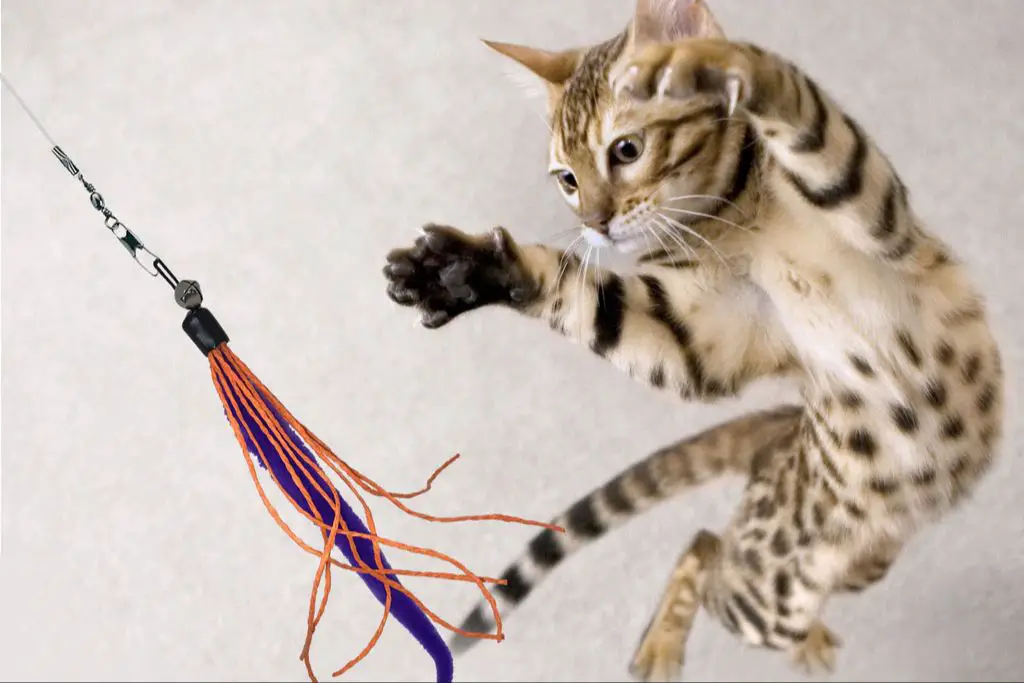Why Your Cat Jumps On Counters
It’s a common predicament for cat owners – you turn your back for just a moment and suddenly your cat is walking across the kitchen counters. Counter surfing, as it’s called, is a perplexing and troublesome behavior for many cat parents. In this article, we’ll explore the reasons behind this behavior and provide tips for keeping your cat off the counters.
Counter surfing is a natural feline behavior but that doesn’t mean we want our cats doing it. The reasons cats jump on counters usually comes down to their instincts, curiosity, and a desire for attention. By understanding what motivates this behavior, we can better address the root causes and re-direct our cats in positive ways.
Natural Instincts
Cats have a natural instinct to perch up high in order to survey their territory. In the wild, climbing trees and rocks allows cats to spot potential prey and monitor for predators or rival cats encroaching on their domain. Jumping on counters and other elevated surfaces in a home taps into this innate desire to view their surroundings from a height. As explained, the drive to climb gives cats “a sense of security, which stems from their instinct to spot a meal—or to keep from becoming a meal.” Domestic cats still possess this evolutionary tendency even when living indoors.

Smells and Food
Cats have a keen sense of smell that is about 14 times stronger than humans. Their sense of smell plays an important role in their attraction to kitchen counters (Thesprucepets.com). Countertops often contain residual smells from foods like raw meat, fish, and milk that can lure curious cats (Wihumane.org). A cat’s strong drive to explore new environments and foods draws them to kitchen counters, even if no food is presently there (Quora.com).
Compared to humans, cats have a superior olfactory system designed to detect food smells from great distances. Their sense of smell leads them to explore counters out of instinctual curiosity and appetite for new foods. Even if counters appear clean to us, cats can still detect leftover scents we can’t sense. This makes kitchen counters intrinsically interesting areas for cats to patrol and investigate.
Boredom
Cats are naturally curious animals that need mental stimulation. When cats lack appropriate outlets and activities in the home, they may act out by jumping on counters to explore and interact with new environments. As one Reddit user explains, “I’m guessing she’s seeking attention” when jumping on counters, indicating it provides mental engagement (source). This need for stimulation is a key reason cats jump on counters when bored.
Without sufficient playtime, toys, cat trees, and other enriching activities, cats can become bored and restless. As veterinarian Katmiller Johnson tells Slate, “The cats know that when they get on the counter, they’ll get your attention. Honestly, it can be a very fun game” for them (source). Jumping on counters becomes an outlet for play and interaction. Providing cats with adequate mental and physical stimulation through playtime, toys, cat trees, puzzles, and more can curb counter jumping that results from boredom and lack of activity.
Owner Attention
Jumping on the counter often gets a cat owner’s attention, even though it may be negative attention (1). The cat learns that jumping up will cause the owner to react, whether it’s by scolding the cat, picking them up and putting them back down, or interacting with them in any way. This human reaction reinforces the behavior, encouraging the cat to continue jumping on counters to get attention. Even negative attention from humans is often better than no attention at all in a cat’s mind.

As one Reddit user commented, “Cats love any attention. Even telling them ‘no’ is attention.” (2) The key is to ignore the cat when they jump on the counter, and reward them with attention when all four paws are on the floor. This lets the cat know the desired behavior to get your affection. It also helps to designate specific play times, and to provide a cat tower or perch near the counter-top level to give them an approved place to climb and survey their domain. With patience and consistency, your cat can learn that only appropriate behavior earns your valued reaction.
Training Tips
There are several methods you can try to train your cat not to jump on counters. One method is to use remote punishment by spraying the cat with water or making a loud noise when they jump up (How To Train A Cat Not To Jump On Counters?, 2023). This startles the cat and makes them associate jumping up with something unpleasant. Some people recommend aluminum foil or double-sided sticky tape on the counter, which cats dislike walking on (Foster FAQ and Forms – Brooklyn Animal Action, 2023). There are also motion-activated devices that can be placed on counters that emit a loud noise or puff of air when triggered.
It’s important not to physically punish the cat when they jump up, as this can make them afraid of you. The key is consistent training and providing more desirable alternatives like cat trees. With time and effort, it’s possible to train most cats not to counter surf. Just be patient and reward good behavior.
Providing Alternatives
One of the best ways to keep cats from jumping on counters is to provide them with acceptable surfaces to climb, perch, and satisfy their natural instincts. According to The Spruce Pets, giving cats designated areas and objects to climb can curb their desire to jump on kitchen counters and tables.
Investing in cat trees, shelves, and perches allows cats to climb and survey their territory from an elevated space. Place cat trees and climbing shelves near windows, which cats enjoy lounging in while watching the outside world. Be sure to select sturdy cat trees and perches that can support your cat’s weight and climbing habits without tipping over.
Cats also appreciate having scratching posts and cardboard scratchers around the house to satisfy their instinctual need to scratch and mark their territory. Providing appropriate scratching surfaces distracted them from choosing counters and furniture. Try different scratcher materials like cardboard, sisal rope, and carpet so your cat has options for scratching preferences.
Giving cats designatedsurfaces and objects to climb, scratch, perch, and play on makes them less likely to see kitchen counters as appealing places to jump up on. It provides an acceptable outlet for their natural behaviors. Check out cat trees and perches designed specifically to entice cats away from counters and tables.
Meeting Needs
It’s important to meet your cat’s needs for exercise, play, and proper nutrition to discourage unwanted behavior like jumping on counters. Cats are natural hunters and explorers, so they need active playtime and environmental enrichment. According to the ASPCA, “Keeping your cat’s brain and body active goes a long way in preventing behavior problems.”1
Make sure your cat has a variety of toys available like feather wands, laser pointers, puzzle feeders and treat balls. Rotate the toys to keep your cat engaged and stimulated. Set aside 10-15 minutes 2-3 times a day for interactive play sessions. In addition, place cat trees, shelves, scratching posts and cardboard boxes around your home so your cat can climb, scratch and play when you’re not actively engaging them.2

It’s also important to feed your cat a diet appropriate for their age, providing the right balance of protein, fat, and carbohydrates. Feed cats several small meals throughout the day since they tend to graze. Make sure clean, fresh water is always available. Food puzzles and activity feeders can provide cognitive stimulation at mealtimes.
Safety Risks
Cats jumping on counters can pose several safety risks that pet owners should be aware of. One major danger is falling. Countertops are elevated surfaces that cats could potentially fall from and injure themselves, especially if they jump down. Hard flooring like tile or wood can make falls worse. Falls from counters could lead to sprains, fractures, or head trauma in cats (1).
Another risk is burns. If cats jump on the stove or areas where hot pans are present, they could seriously burn their paws or face. Even jumping near an open oven door or toaster could lead to burns. Chemical or heat burns are also a possibility if cats walk on recently cleaned counters before they fully dry (2).

Additionally, cats jumping on counters could ingest toxic cleaners, chemicals, or human foods that may be present. Cleaning products, soaps, alcohol, and certain people foods can cause poisoning in cats when ingested. Pet owners should be diligent about storing these items securely and cleaning up spills quickly (1).
To prevent injuries from counter surfing, pet owners can cat-proof their home. Using child locks on cupboards, keeping counters free of clutter, storing harmful items out of reach, and keeping cats out of the kitchen when not supervised are some tips. Providing plenty of cat towers, shelves, and approved surfaces for cats to climb on can also help divert them from unsafe counters (2). Keeping counters free of tempting smells and foods is key as well. With some training and home adjustments, owners can help keep their cats safe.
(1) https://www.thesprucepets.com/how-to-keep-cats-off-counters-551798
(2) https://www.webmd.com/pets/cats/keeping-cat-countertops-tables
Conclusion
In summary, cats jump on counters for various reasons, including their natural instincts, boredom, seeking owner attention, and smells/food. While it can be frustrating for owners, there are effective training methods and alternatives to help curb this behavior. Providing cats with adequate playtime, treats, cat trees/perches, and affection can help satisfy their needs. With positive reinforcement and ignoring unwanted behaviors, most cats can be trained not to jump on counters. It’s important that owners understand their cat’s motivations and meet their needs through proper care and training. With patience and consistency, owners can have a happy cat that keeps all four paws on the floor.

